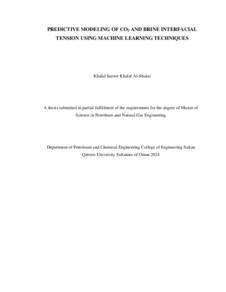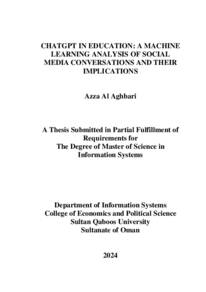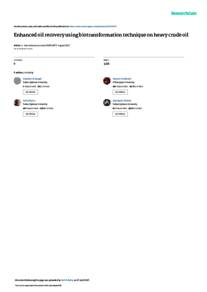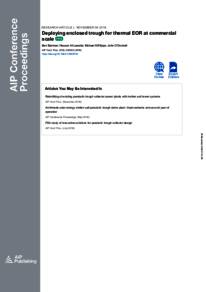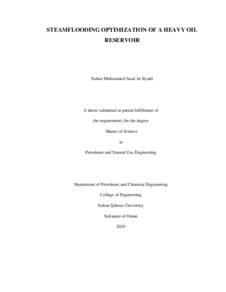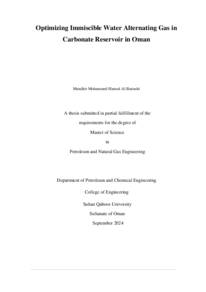Document
Predictive modeling of Co2 and brine interfacial tension using machine learning techniques.
Source
Master's thesis
Other titles
نموذج تنبؤي للتوتر السطحي بين ثاني أكسيد الكربون والماء المالح باستخدام تقنيات تعلم الآلة
Country
Oman
City
Muscat
Publisher
Sultan Qaboos University
Gregorian
2024
Language
English
Thesis Type
Master's thesis
English abstract
This thesis focuses on the development of a predictive model for the interfacial tension
(IFT) between carbon dioxide (CO2) and brine using advanced machine learning
techniques. Accurate prediction of IFT is crucial for optimizing processes in carbon
capture and storage (CCS) and enhanced oil recovery (EOR), both of which are vital for
energy production and environmental management. Traditional experimental methods to
measure IFT, while precise, are often expensive and time-consuming. This research aims
to create a robust and efficient regression model to predict IFT, thereby reducing the
reliance on extensive experimental procedures.
Utilizing data from extensive literature reviews and experimental studies, this thesis
develops and compares several machine learning models including Linear Regression,
Multi-Layer Perceptron (MLP), Decision Tree Regressor, and K-Nearest Neighbors
(KNN). The models are developed using data that includes various temperatures,
pressures, salinity levels, and types of salts. Their performance is assessed using metrics
like the coefficient of determination (R²) and Mean Absolute Error (MAE), with repeated
K-fold cross-validation applied to ensure the models are robust and can generalize well.
The results indicate that machine learning models, particularly the Decision Tree
Regressor and Multi-Layer Perceptron (MLP), offer high predictive accuracy for CO2 and
brine IFT across varied conditions. This thesis also includes a comparative analysis of the
best-performing models against existing empirical correlations and experimental data,
demonstrating significant improvements in prediction accuracy.
By integrating machine learning techniques with traditional experimental data, this
research contributes to the field of fluid dynamics, offering a cost-effective and reliable
method for predicting IFT.
Arabic abstract
تركز هذه الرسالة على تطوير نموذج تنبؤي للتوتر السطحي )IFT )بين ثاني أكسيد الكربون )2CO )والماء المالح باستخدام تقنيات تعلم الآلة المتقدمة. يُعد التنبؤ الدقيق بالتوتر السطحي أمًرا حيويًا لتحسين عمليات احتجاز الكربون وتخزينه )CCS )والاستخالص المحسن للنفط )EOR)، وكالهما ضروري إلنتاج الطاقة وإدارة البيئة. تُعد الطرق . تهدف هذه الدراسة التجريبية التقليدية لقياس التوتر السطحي دقيقة لكنها غالبًا ما تكون مكلفة وتستغرق وقتًا طويالً إلى إنشاء نموذج انحدار قوي وفعال للتنبؤ بالتوتر السطحي، وبالتالي تقليل الاعتماد على الاجراءات التجريبية المكثفة. باستخدام البيانات المستمدة من مراجعات الادبيات الشاملة والدراسات التجريبية، تطور هذه الرسالة وتقارن بين عدة نماذج تعلم آلي بما في ذلك Regression Linear، و(MLP (Perceptron Layer-Multi، و Tree Decision Regressor، و (KNN (Neighbors Nearest-K. تم تدريب النماذج باستخدام بيانات تغطي مجموعة من درجات الحرارة والضغوط والمحتويات الملحية وأنواع الأملاح تم تقييم أداء هذه النماذج من خلال مقاييس مثل معامل التحديد )²R )ومتوسط الخطأ المطلق )MAE)، مع استخدام التحقق المتقاطع المتكرر لضمان المتانة والقابلية للتعميم. تشير النتائج إلى أن نماذج تعلم الآلة، وخصو ًصا Regressor Tree Decision ، و Perceptron Layer-Multi (MLP(، توفر دقة تنبؤية عالية للتوتر السطحي بين ثاني أكسيد الكربون والماء المالح في ظل ظروف متنوعة. ًء مقابل التوافقات التجريبية والبيانات التجريبية الموجودة، ًال مقارنًا للنم تتضمن هذه الرسالة أي ًضا تحلي اذج الافضل أدا مما يظهر تحسينات كبيرة في دقة التنبؤ. من خلال دمج تقنيات تعلم الآلة مع البيانات التجريبية التقليدية، تساهم هذه الدراسة في مجال ديناميات السوائل، حيث تقدم طريقة موثوقة وفعالة من حيث التكلفة للتنبؤ بالتوتر السطحي.
Category
Theses and Dissertations

